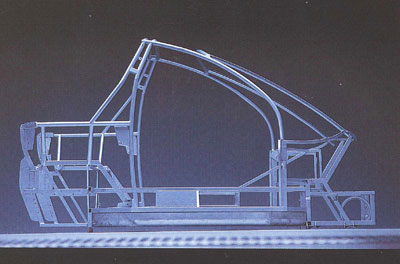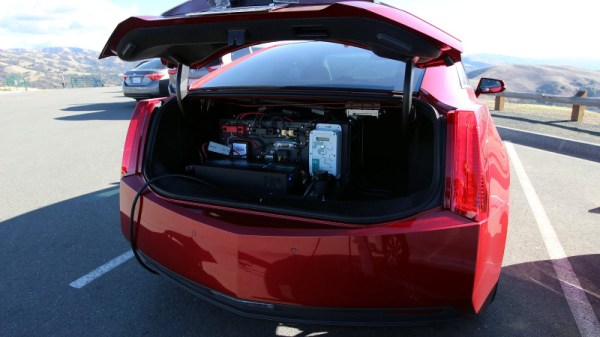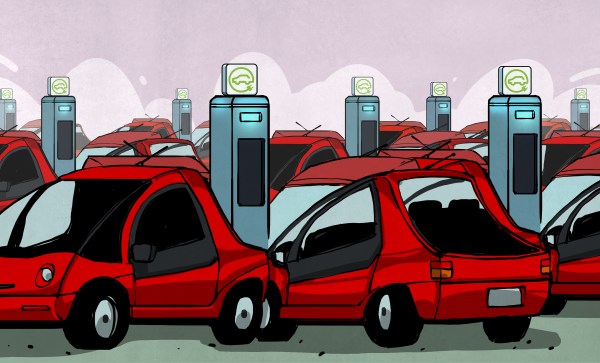[Quasse] bought a 1978 Honda NC50 Express moped with the intention of fixing it up and riding it, only to find that the engine was beyond repair. So, they did what any self-respecting hacker would do: tear out the motor and replace it with an electric one. It’s still a work in progress, but they have got it up and running by replacing the engine with a Turnigy SK3 6374 motor, a 192KV motor that [Quasse] calculated should be able to drive the moped at just over 30 miles per hour. Given that this was the top speed that the NC50 could manage on gas power, that’s plenty fast.
ev95 Articles
Charge Your EV The Portable Way
[Andrew Rossignol] has a slightly unusual plug-in hybrid vehicle, a Cadillac ELR, and his latest project for the car sees him building a battery-powered portable mains charging pack for it in an attempt to increase its range. If this seems to be a rather cumbersome exercise, his write-up details the work he put in trying to hook up directly to the car’s internal battery, and how a 4 kW mains inverter and an off-the-shelf mains charging station were the most practical alternative.
His first impulse was to hook a second supply to the car’s high voltage bus from a supplementary battery pack and inverter, but in this aim he was thwarted by a protection diode and his not wanting to modify the car to bypass it. So the unlikely solution was to take his battery pack from a second-hand Toyota Prius upgrade kit and build it into a frame along with the inverter and charger. The result is something akin to a portable generator without the small gasoline engine, and while it is hardly the most efficient way to transfer energy from a wall socket into a car it does offer the ELR a significant range upgrade.
The cost involved has probably kept away many readers who would like to hack their hybrid cars, so we’ve seen surprisingly few. This home made Geo Metro supplements its forklift motor with a small gasoline generator. Meanwhile [Andrew] is no stranger to these pages, among the several times his work has appeared here are his rundown on OBD sniffing the ELR, and from a while back, displaying graphics on an oscilloscope including a Wrencher.
A 1940s Gangster-Mobile Gets An Electric Makeover
When referring to classic cars, there’s a good reason that “they don’t make ’em like that anymore.” Old cars represented the limits of what could be done in terms of materials and manufacturing methods coupled with the styles of the time and cheap fuel. The result was big, heavy cars that would cost a fortune in gas to keep on the road today.
Some people just don’t want to let those styles go, however, and send their beast off for some special modifications. This 1949 Mercury coupe with an electric drivetrain conversion is one way of keeping that retro look alive. Granted, the body of the car is not exactly showroom quality anymore, from the light patina of rust on its heavy steel body panels to the pimples cropping up under its abundant chrome. But that’s all part of the charm; this comes from conversion company Icon’s “Derelict” line, which takes old vehicles and guts them while leaving the outside largely untouched. This Mercury was given a fully electric, 298 kW drivetrain. The engine bay and trunk, together roomier than some Silicon Valley studio apartments, provided ample room for the 85 kWh Tesla battery pack and the dual electric motors, with room left over to craft enclosures for the battery controllers that look like a V8 engine. Custom electronic gauges and controls that look like originals adorn the chrome-bedazzled dash. The beast tops out at 120 mph (193 km/h) and has a 200 mile (322 km) range before it has to find a Tesla supercharger. Or a lemonade stand.
Say what you want about the old cars, but they had plenty of style. We appreciate the work that went into this conversion, which no doubt cost more than all the gas this thing has ever guzzled.
Thanks to [Qes] for the tip.
Car Revival According To Tesla
Frankencars are built from the parts of several cars to make one usable vehicle. [Jim Belosic] has crossed the (finish) line with his Teslonda. In the most basic sense, it is the body of a Honda Accord on top of the drive train of a Tesla Model S. The 1981 Honda was the make and model of his first car, but it wasn’t getting driven. Rather than sell it, he decided to give it a new life with electricity, just like Victor Frankenstein.
In accord with Frankenstein’s monster, this car has unbelievable strength. [Jim] estimates the horsepower increases by a factor of ten over the gas engine. The California-emissions original generates between forty and fifty horsepower while his best guess places the horsepower over five-hundred. At this point, the Honda body is just holding on for dear life. Once all the safety items, like seatbelts, are installed, the driver and passengers will be holding on for the same reason.
This kind of build excites us because it takes something old, and something modern, and marries the two to make something in a class of its own. And we hate to see usable parts sitting idle.
Without a body, this electric car scoots around with its driver all day, and this Honda doesn’t even need the driver inside.
Tesla Model S Battery Pack Teardown
We’ve heard a lot about the Tesla Model S over the last few years, it’s a vehicle with a habit of being newsworthy. And as a fast luxury electric saloon car with a range of over 300 miles per charge depending on the model, its publicity is deserved, and that’s before we’ve even mentioned autonomous driving driver-assist. Even the best of the competing mass-produced electric cars of the moment look inferior beside it.
Tesla famously build their battery packs from standard 18650 lithium-ion cells, but it’s safe to say that the pack in the Model S has little in common with your laptop battery. Fortunately for those of a curious nature, [Jehu Garcia] has posted a video showing the folks at EV West tearing down a Model S pack from a scrap car, so we can follow them through its construction.
The most obvious thing about this pack is its sheer size, this is a large item that takes up most of the space under the car. We’re shown a previous generation Tesla pack for comparison, that is much smaller. Eye-watering performance and range come at a price, and we’re seeing it here in front of us.
The standard of construction appears to be very high indeed, which makes sense as this is not merely a performance part but a safety critical one. Owners of mobile phones beset by fires will testify to this, and the Tesla’s capacity for conflagration or electrical hazard is proportionately larger. The chassis and outer cover are held together by a huge array of bolts and Torx screws, and as they comment, each one is marked as having been tightened to a particular torque setting.
Under the cover is a second cover that is glued down, this needs to be carefully pried off to reveal the modules and their cells. The coolant is drained, and the modules disconnected. This last task is particularly hazardous, as the pack delivers hundreds of volts DC at a very low impedance. Then each of the sixteen packs can be carefully removed. The packs each contain 444 cells, the pack voltage is 24 V, and the energy stored is 5.3 kWh.
The video is below the break. We can’t help noticing some of the rather tasty automotive objects of desire in their lot.
Cheap Electric Car Drives Again With Charger Repair
If someone sent you an advert for an electric car with a price too low to pass up, what would you do? [Leadacid44] was in that lucky situation, and since it was crazy cheap, bought the car.
Of course, there’s always a problem of some kind with any cheap car, and this one was no exception. In this case, making it ‘go’ for any reasonable distance was the problem. Eventually a faulty battery charging system was diagnosed and fixed, but not before chasing down a few other possibilities. While the eventual solution was a relatively simple one the write-up of the car and the process of finding it makes for an interesting read.
The car in question is a ZENN, a Canadian-made and electric-powered licensed version of the French Microcar MC2 low-speed city car with a 72 volt lead-acid battery pack that gives a range of about 40 miles and a limited top speed of 25 miles per hour. Not a vehicle that is an uncommon sight in European cities, but very rare indeed in North America. Through the write-up we are introduced to this unusual vehicle, the choice of battery packs, and to the charger that turned out to be defective. We’re then shown the common fault with these units, a familiar dry joint issue from poor quality lead-free solder, and taken through the repair.
We are so used to lithium-ion batteries in electric cars that it’s easy to forget there is still a small niche for lead-acid in transportation. Short-range vehicles like this one or many of the current crop of electric UTVs can do without the capacity and weight savings, and reap the benefit of the older technology being significantly cheaper. It would however be fascinating to see what the ZENN could achieve with a lithium-ion pack and the removal of that speed limiter.
If your curiosity is whetted by European electric microcars, take a look at our previous feature n the futuristic Hotzenblitz, from Germany.
EV History: The Lightning Precedes The Thunder
In 1988, a bunch of engineers from Hotzenwald, Germany, came together and decided that it is time for the future of mobility: A new, more modern and environmentally friendly car should put an end to fossils and emissions while still being fun to drive. “It should become a new kind of car. Smaller, lighter, cleaner – and more beautiful” is how future CEO Thomas Albiez described his mission. For the first time in automotive history, this series car would be designed as an all-electric vehicle from the start and set a new standard for mobility. The project was given the codename “Hotzenblitz” (“Hotzen Bolt”) to indicate how the idea came to them: Like a lightning bolt. The snarky regional term also came with a double meaning: Imaginary lightning bolts, used for insurance fraud.

Unnoticed by the rest of the world, they founded Hotzenblitz Mobile. Industrial Designer Harold Schurz was contracted to design the chassis for the Hotzenblitz, which was then modeled into a prototype chassis. The self-funded team moved fast. An external motorsports company helped to develop the tubular steel frame, and soon their vision took on shape. After the team had fitted a motor and transmission into the frame, CEO Thomas Albiez himself installed the traction battery and drive train. The team felt confident with the result, and in July 1990, during an open house day in the office, they somewhat spontaneously decided to call Green Tech entrepreneur and chocolate mogul Alfred Ritter.
Alfred Ritter had experienced financial losses after the Chernobyl Disaster. Many agricultural regions, including several hazelnut plantations that were vital to Alfred’s chocolate business, were irreversibly lost to the fallout contamination. It was then when he turned to the green energy business, founding the Paradigma group to manufacture solar collector systems and pellet heaters. When Thomas and the team called, Alfred jumped on the idea of an electric car. In the same year, Alfred Ritter and his sister Marli Hoppe-Ritter became shareholders in the company and helped to finance the future of the Hotzenblitz.
Continue reading “EV History: The Lightning Precedes The Thunder”
















